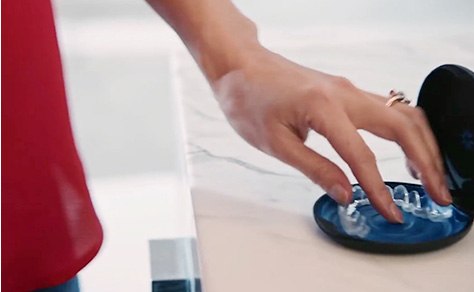Invisalign’s clear aligners are made of soft, flexible plastic that are virtually undetectable when worn over your teeth.
The mouthpiece is worn for at least 20 hours a day to gradually move the teeth, but can be removed for brushing and eating.
Unlike traditional bracket-and-wire braces that are fixed to your pearlies throughout the treatment, Invisalign’s custom-made oral appliances can be removed, making it easy to eat or clean your teeth.
The mouthpiece is very thin, transparent and inconspicuous and is recommended for people who want to fix their teeth without worrying about their surroundings.
Invisalign treatment costs?
Since every case is different, it would be difficult to apply one-size-fits-all pricing for every patient.
There are many broad variables that affect the cost of treatment, such as the complexity of the case and length of treatment.
As a guide, the cost for an Invisalign treatment in Sydney ranges between A$6500 to A$9500.
The Dental Clinic @ World Tower offers five courses depending on the case, starting at $3995.

Approximately every 1 weeks, the dentist would replace your aligner with a new one until completing the full series of aligners as set out in the treatment plan.
Each aligner has a different shape that conforms to your specific teeth position at different stages of the straightening process – applying varying degrees of minute forces to gradually move your teeth to their desired position.
The number of aligners you’ll require depends on your specific type and extent of alignment problem.
The more aligners you require, the higher the expected costs.
The nature of your alignment problem, whether mild crowding or a severe one with aggravated bite issues, will determine how much teeth movement is necessary before proper alignment can be achieved. More extensive movements would entail a longer and more costly procedure.

Treatment process
Creating a treatment plan
The Invisalign Doctor will take photographs, x-rays and digital scans or impressions of the teeth to develop a treatment plan.

Creating a 3D treatment plan
Using Align Technology’s proprietary 3D treatment planning software, the doctor creates a treatment plan for the patient.
This 3D treatment plan shows the predicted final position of the teeth and the approximate duration of treatment.

Production and shipment of aligners
Customised aligners are manufactured and shipped to the doctor’s clinic
Fitting of aligners
The aligners are given to the patient.
The patient wears the aligners daily and replaces them with new ones every 1-2 weeks
Checking the progress of your treatment
You will visit the clinic approximately every 6-8 weeks to see your Invisalign doctor to check the progress of your treatment.
End of treatment
Retainers (retainer devices) must be used to stabilise the position of the teeth after treatment is completed. Not included in the Invisalign treatment fee.
To get you started with treatment, please call our friendly team on 02 9269 0514!
◆ www.bestdentist.com.au ◆
Dr Knox Kim is Invisalign’s Diamond Invisalign Provider and Invisalign’s only Clinical consultant/ Speaker among General dentists in Australia
Top 6th in the world in Invisalign International Gallery, Principal dentist at Sydney CBD and vice principal dentist at Tokyo, Finished over 1,500 Invisalign patients in both Sydney and Tokyo,
treating over 400 patients in both clinics, Invisalign’s official lecturer, lecturing at Shangai, Hangzhou, Seoul, Tokyo, Osaka, Nagoya, Las Vegas, and all the major cities in Australia and New Zealand
#
Information Disclaimer
The content of this article is meant for informational purposes only and should not be considered a source of professional advice, recommendations, or endorsements. It is not a substitute for seeking expert guidance or making well-informed decisions based on individual circumstances. Although we strive for accuracy and reliability, we cannot guarantee the information's completeness or suitability for all situations. Readers are urged to verify facts, consult experts, and consider their own context before taking actions or decisions based on this content. No warranties, explicit or implied, are provided regarding the accuracy, timeliness, or completeness of the presented information. Relying on this information is at the reader's own discretion and risk. We encourage readers to consult relevant professionals or experts for advice tailored to their specific needs. Neither the author, publisher, nor any affiliated parties will be held responsible for errors, omissions, or damages resulting from the use or reliance on the information in this article.




